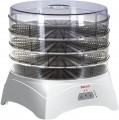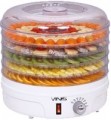Drying levels
The number of separate trays on which food can be placed during drying.
The design of the trays in food dryers can vary. Typically, they consist of separate closed compartments, but another option is a common chamber with shelves (refer to the "Location of the fan (heater)" section for more information). Regardless of the specific design, the trays are positioned vertically, with multiple trays or "floors" in modern food dehydrators. The most modest option is actually
3 trays;
4 trays — also quite a small number;
5-tray dehydrators are the most popular; noticeably less common models with
6 trays or
8 trays; and in individual devices
9 or more trays can be provided (12, and sometimes 20).
Using multiple trays or "floors" in a food dehydrators ffers several advantages. It allows for increased capacity while maintaining a compact width and depth for the entire device. The more tiers there are, the smaller the area of each individual tray becomes, enabling a smaller overall width and depth of the dehydrator. This is particularly beneficial when space is limited on a table or surface, but there is ample vertical space available. Additionally, having multiple trays allows for simultaneous drying of different types of products with varying drying times. By using ce
...rtain techniques, individual compartments and shelves can be removed without having to turn off the device. However, it's important to note that increasing the number of levels in the device affects its height and cost, reduces the capacity of each individual tray, and necessitates the use of more powerful fans to ensure even heat distribution.
It's important to note that the presence of numerous trays does not necessarily indicate a powerful or spacious food dehydrator. This design can be found in compact models as well. Devices with 3-4 tiers often do not significantly differ in capacity, although there may be exceptions to this.
At the same time, there are also models whose equipment with trays significantly exceeds the number of drying levels. But our paragraph indicates how many levels (trays) can be used simultaneously when drying.Power consumption
Rated power consumed by the dryer during operation.
This parameter is usually selected by manufacturers depending on the volume of the dryer: the larger the device, the more power is needed to effectively heat the working chamber. At the same time, models with the same volume may differ in power consumption. In such cases, it is worth considering that a higher power reduces the heating time, but affects the price of the device.
Temperature range
The temperature range that the dryer can provide in the working chamber.
The simplest models provide only one operating temperature option, usually from 50 °C to 60 °C. More advanced devices equipped with thermostats (see above) and can have a wide range of adjustment — this is very useful, because different temperature regimes are recommended for different products. To assess the general capabilities of a particular dryer, you can use the following table of temperatures recommended for drying:
— 35...40 °C — plant stems, greens;
— 40...45 °C — bread;
— 38...42 °C (in some cases up to 45 °C) — yoghurt;
— 50...55 °C — vegetables;
— 55...60 °C — fruits;
— 65...75 °C — meat, fish.
We emphasize that these are the most general, conditional data. The specific temperature may differ from the recommended one — depending on the thickness of the slices, the specific type of food, the desired result, etc. Detailed recommendations on this matter can be found in special sources.
Control
The control panel of a fruit dehydrators.
— Control knob.
Mechanical control is carried out using rotary knobs and switches. Most parameters in such devices are set and controlled manually. In this case, the control elements are connected to the working parts of the dryer directly, without additional electronic circuits. This option is simple, reliable and low cost; however, it is only suitable for the most basic functions, but dehydrators for fruits, vegetables and mushrooms usually do not require more. But the obvious disadvantage of mechanical control is low accuracy: for example, a mechanical timer most often gives an error of a couple of minutes, which in some cases can be critical.
–
Push-button. Push-button control is based on electronic circuits. Such systems are more accurate than mechanical ones (for example, the timer in such dryers can usually be set with an accuracy of several seconds), and more options and modes are provided. On the other hand, such control is more complex and more expensive than mechanical control.
–
Touch. A type of
electronic control with touch switches. Compared to push-button models, it provides a high level of comfort in operation, and looks more modern and aesthetically pleasing. Touch control is found mainly in top models of dehydrators.
Shutdown timer
A special device that turns off the heating after a predetermined time.
The presence of a
timer greatly simplifies the use of the device: instead of monitoring the duration of the process and manually turning off the heater, it is enough to set the desired turn-off time in the settings. In addition, this function reduces the risk of forgetting about drying products and “overexposing” them in the dryer: this can only happen if the timer was initially set for too long.
Note that the type of timer directly depends on the type of control (see above); at the same time, mechanical timers are simple and inexpensive, but they have a rather noticeable error, and electronic ones are very accurate, but they cost accordingly more.

